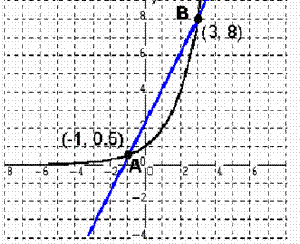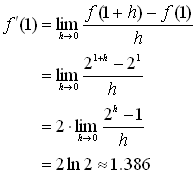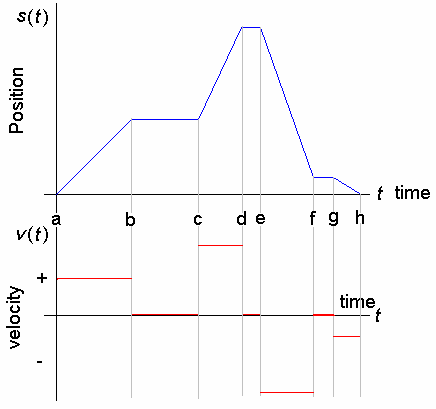| Numerical Approximation. The derivative is the difference quotient
applied to two values in a tabulation of function values. For example,
suppose the following table describes the population, in thousands, of a city as
a function of time. |
| Year |
1998 |
1999 |
2000 |
2001 |
2002 |
| Pop. |
23 |
25 |
28 |
26 |
25 |
|
| Since we do not know the analytic function that represents the
population, we are unable to use an algebraic derivative. Therefore, we
use the difference quotient.
|
|
 |
| Necessarily, the derivative that we
calculate is an estimate. Suppose we need to know the derivative of the
population function for 2001. The estimated rate of change can be found
three ways.
|
| 1. The rate
of change from 2000 to 2001 ("left rate of change") is |
|
 |
|
The interpretation of this result is that the population was decreasing at a
rate of 2000 people per year in 2001.
|
|
2. The rate of change from 2001
to 2002 ("right rate of change") is
|
|
 |
|
The interpretation of this result
is that the population was decreasing at a rate of 1000 people per year in
2001.
|
|
3. A more believable value
for the derivative of the population function for 2001 is obtained if we
take the mean of these results. The mean can also be found by finding the
rate of change from 2000 to 2002 ("midpoint rate of change"): |
|
 |
|
The interpretation of this result
is that the population was decreasing at a rate of 1500 people per year in
2001.
|
| Definition. The
definition of the derivative is the difference quotient in the limit that
the distance between the two points over which the rate of change is
calculated shrinks to zero. The definition of the derivative is given by |
|

|
Consider the graph of the
function f(x)
= 2x shown below. How much is the derivative (rate of
change) at the point on the graph where x = 1?
|
|
|
|
|
 |
 |
The slope of the secant line AB approximates
the derivative of the function f(x) = 2x at
the point (1, 2). The calculation is

|
The slope of the tangent line through point A
is the derivative (or instantaneous rate of change) of the function f(x)
= 2x at the point (1, 2). The calculation is

|
| |
|
| Graphically, the derivative is
associated with the slope of a line tangent tangent to a point on the graph
of a function (see also
Linear Approximations). This type of rate of change is called an
"instantaneous" rate of change because it is not taken between two points,
but occurs at one point only. Compare the two graphs above.
We can easily justify this notion by graphing
a function, then repeatedly zooming in on the point. This repeated
zooming causes the graph to look linear, a condition that we refer to as
"local linearity:" that is, all continuous functions look like lines if we
restrict our view to a sufficiently small neighborhood of x. Many
students think of this as the "slope" of the curve, an idea that, while
technically not "rigorous," can be quite useful and instructive. |
| |
| Analytically. If
the function we are interested in is continuous (no holes, gaps, or jumps)
and if it is "smooth" (no corners) over the interval of interest, then the
derivative is also a function over that interval. When these
conditions are met, we say the function is differentiable on that
interval. The definition of the derivative, cited above, can be used
to find the derivative function. In principle, the
definition can be used to find any derivative. However, in practice,
the algebra can be very labor intensive and inefficient. Several
derivative forms should be easy to derive for a calculus student.
These include the derivative of the power function, the derivative of an
exponential function, and the derivatives of sine and cosine. Using
these as a basis and the appropriate limit theorems and the product,
quotient, and chain rules of derivatives, essentially any derivative can be
analytically determined.
|
| Verbally. The
practical meaning of the derivative is important to us when the functions we
study involve models of real world phenomena. Take, for example, a car
moving along a highway where the car's distance s(t) from its
starting point (that is, s when t = 0) is a function of time.
The derivative of the distance s'(t) = v(t) is
the car's velocity. This velocity is simply the rate of change of the
car's position with respect to time. If we view a graph of s(t)
versus t, we might see something like that shown below. |
|
 |
| At time a, our driver needing to
deliver an important report, starts out from home and drives at a constant
speed, say 40 mph for 1 hour. This is illustrated by the blue graph on the
interval (a, b). The corresponding red velocity graph (the derivative
of the distance traveled) shows a positive velocity of 40 mph. She then
stops for lunch for another hour. The blue graph is horizontal, because her
distance from home is not changing. Consequently, her speed is also
zero. After lunch, she gets onto the freeway and travels at 60 mph for
another 40 minutes. By this time, she is 80 miles from home. The
red graph shows the higher speed on the interval (c, d). She reaches
her destination, delivers the report after spending a few minutes explaining
its importance to her colleague. At time e, she gets back onto the freeway
and drives home at a speed of 70 mph. Notice that the red graph shows
a negative velocity now. This is because the distance between where
she is and home is decreasing. After 50 minutes of driving, she
gets off the freeway so that she can stop at the store for a few groceries.
Again, the blue graph is horizontal, and the red graph is zero on (f, g).
She drives the remaining few miles home at 30 mph completing the journey at
time h. |
| Important remarks:
- When the function is increasing, the derivative is
positive.
- When the function is decreasing, the derivative is
negative.
- When the function is constant, the derivative is
zero.
- The value of the derivative at any time t or
value of x is the rate of change of the function at that t
or value of x.
- The units of the derivative are the function's
vertical units over the function's horizontal units.
|
| For algebraic equations,
specific rules, or "shortcuts" are employed for finding derivatives for
the different family of functions that we study and model with. |
![]()
![]()
![]()
![]()





